As a platform, Seesaw lets students blend pictures, video, voice-over, annotation tools, and external resources. It can be a powerful platform for both creation and reflection. Typically, Seesaw is used by elementary educators because it caters to kids -- it’s icon heavy, makes providing voice and video instructions easy, and because it is web-based, is easily accessed on Chromebooks. Secondary teachers, don’t stop reading yet…
Middle School teacher Kristy Fair at Gene Pike Middle School is engaging her 6th-grade students through Seesaw. For Veterans Day and as a part of their nonfiction unit, she had her students read an article from Wonderopolis and then create a presentation about what they learned. Beginning with a lesson from Seesaw’s Activity library, which is filled with pre-created activities for K-12 for all contents, Mrs. Fair modified the assignment and instructions to better meet her students' needs. She added voice instructions and asked her students to make personal connections to Veterans day before sharing their research with the class.
What I love about this lesson is that she asks her students to reflect, make connections, and create a resource to share with their classmates all based on what they read. A lesson like this is flexible -- it can easily be made more or less challenging depending on the article linked in and on the level of critical thinking students are being asked to show in their evidence of learning. She modified the task to meet her students' needs. Regardless, Seesaw and Google Slides are simply the tools through which Mrs. Fair assigned and assessed student's comprehension and learning.
I observed her classes using Seesaw and witnessed first-hand how excited and engaged her middle schoolers were while using Seesaw. They loved sharing their work so that their classmates could see it, and were quick to leave each other positive feedback on what they shared. They were eager to participate -- one student went so far as to respond to the Veterans Day assignment from home the morning before class, sharing a video reflection about how his great-great-grandfather was a veteran.
As a former-high-school-teacher-turned-Instructional-Coach, I had admittedly written this tool off as an elementary-only resource, but working with secondary teachers and students in Seesaw quickly showed me how useful this platform can be for meeting the needs of students of all ages and ability. At its core, Seesaw is a platform for sharing and curating work, for synthesizing thinking and evidence of learning in one easy-to-use and easy-to-share place. As an added bonus it seamlessly integrates with Google Classroom, which many secondary teachers are already using. Seesaw creates choice and flexibility in how students share their learning. Whether asking students to snap a picture of their journal, annotate and reflect on what they wrote or asking students to upload their lab data and reflect on the implications of their scientific findings using videos, Seesaw can amplify the reflections and learning that happens in secondary classrooms.
Below are a few pre-created secondary Seesaw lessons for various contents that can all be found in the Activity Library. How will you use Seesaw in your secondary classroom?


No comments:
Post a Comment
Note: Only a member of this blog may post a comment.